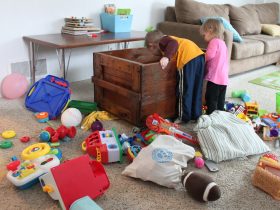As a child psychologist with over 15 years of clinical experience, I’ve witnessed countless parents express bewilderment at their children’s dramatically different behaviors across settings. Sarah, mother of 7-year-old Ethan, recently shared: “At parent-teacher conferences, I barely recognize the child they describe. The boy who throws hour-long tantrums over homework is the same one his teacher calls ‘a model student.'” This phenomenon isn’t exceptional—it’s the norm. Research from the Child Mind Institute indicates approximately 68% of children display significantly different behaviors between home and school environments.
Why Some Children Thrive in the School Environment
The Power of Predictable Structures
School environments provide what renowned pediatric psychologist Dr. Rebecca Berry calls “an architecture of predictability.” Classrooms typically feature:
-
Visual schedules prominently displayed
-
Clear transitions signaled by bells or chimes
-
Consistent routines for activities
-
Explicit behavioral expectations
For children with executive function challenges (including approximately 9.4% of children diagnosed with ADHD), this structure serves as an external organizational system their developing brains haven’t yet internalized. A 2022 study in the Journal of Educational Psychology demonstrated that structured environments can improve task completion by up to 42% for these children compared to less structured settings.
The Social Motivation Factor
Human brains contain specialized circuitry for social cognition that becomes particularly active during middle childhood (ages 6-12). Dr. Matthew Lieberman’s UCLA research on social motivation reveals:
-
Peer approval activates the same reward centers as material gains
-
Social exclusion triggers pain responses in the anterior cingulate cortex
-
Children will modify behavior to maintain social standing
This explains why many children exert extraordinary effort to comply with classroom norms—their neurobiology compels them to seek social belonging. The “audience effect” (behavior modification when observed) peaks between ages 8-14 according to developmental studies.
Specialized Reinforcement Systems
Effective teachers employ sophisticated behavioral reinforcement strategies:
-
Proximity praise: Compliant behavior is immediately recognized
-
Group contingencies: Whole-class reward systems leverage peer influence
-
Response cost: Loss of privileges follows rule violations
-
Token economies: Points exchangeable for tangible rewards
These systematic approaches create what behavioral psychologists call “discriminative stimuli”—environmental cues that signal which behaviors will be reinforced. Home environments typically lack this level of intentional behavioral engineering.
Cognitive Load Distribution
Modern classrooms incorporate numerous supports that reduce cognitive burden:
-
Graphic organizers for complex tasks
-
Step-by-step instructions
-
Scaffolded learning sequences
-
Peer collaboration opportunities
These supports allow children to channel mental resources toward behavioral regulation. At home, where such supports are often absent, the same tasks may overwhelm a child’s cognitive capacity, leading to frustration and behavioral dysregulation.
The Exhausting Reality of Symptom Suppression
The Masking Phenomenon
Many children engage in “masking”—consciously or unconsciously suppressing neurodivergent traits to conform to social expectations. Research on autistic children shows:
-
72% report suppressing stimming behaviors at school
-
68% consciously mimic peer body language
-
Average masking duration exceeds 5 hours daily
This constant self-monitoring depletes mental energy reserves, contributing to the after-school “collapse” many parents observe.
The Restraint Collapse Effect
Dr. Mona Delahooke, author of “Beyond Behaviors,” explains restraint collapse as “the inevitable release of pent-up regulatory energy after prolonged self-control.” Key characteristics include:
-
Typically occurs within 90 minutes after school
-
More severe in children with sensory processing differences
-
Often misinterpreted as willful disobedience
Neuroimaging studies show that the prefrontal cortex (responsible for self-regulation) shows significantly reduced activity during restraint collapse, explaining why logical reasoning often fails during these episodes.
Environmental Contrast Effects
Schools and homes differ dramatically in sensory aspects:
| School Environment | Home Environment |
|---|---|
| Fluorescent lighting | Natural or warm lighting |
| Hard surfaces amplifying noise | Soft furnishings absorbing sound |
| Regulated temperature | Variable home temperatures |
| Limited personal space | Often more physical freedom |
For sensory-sensitive children (approximately 1 in 6 according to SPD Foundation), these differences necessitate constant physiological adjustment, contributing to dysregulation.
Why Home Environments Foster Success for Some Children
The Secure Attachment Advantage
Decades of attachment research demonstrates that children in secure attachment relationships:
-
Show 40% greater risk-taking in learning
-
Display more authentic emotional expression
-
Recover from frustration 25% faster
Home environments rich in attachment security provide what Dr. Dan Siegel terms a “secure base” for exploration—a psychological safety net unavailable in institutional settings.
Personalized Learning Modalities
While schools must teach to general norms, homes can accommodate individual learning profiles:
-
Temporal flexibility: Allowing movement breaks when needed
-
Multimodal instruction: Combining visual, auditory, and kinesthetic approaches
-
Interest-based learning: Following the child’s natural curiosities
-
Pace adjustment: Spending extra time on challenging concepts
A 2023 Harvard study found that personalized learning approaches improved task persistence by 58% compared to standardized methods.
Reduced Performance Anxiety
Standardized testing culture creates what psychologist Dr. Wendy Mogel calls “achievement pressure.” Home learning often lacks:
-
Social comparison
-
Graded evaluations
-
Strict time constraints
-
Public performance demands
This reduced pressure allows many children to engage with material more freely and creatively.
Evidence-Based Strategies for Behavioral Integration
Bridging the Home-School Divide
-
Behavioral cross-training:
-
Teachers share successful strategies with parents
-
Parents communicate effective home approaches to teachers
-
Create consistency in reinforcement systems
-
-
Environmental mapping:
-
Identify key differences between settings
-
Gradually incorporate school-like structures at home
-
Bring home comforts into school when possible
-
-
Energy budgeting:
-
Teach children to monitor their regulatory reserves
-
Create “recharging” routines after school
-
Schedule demanding tasks during peak energy times
-
Cognitive-Behavioral Techniques
-
Emotion forecasting:
-
“I notice you’re getting frustrated. Let’s pause before continuing.”
-
-
Coping skill menus:
-
Visual lists of regulation strategies
-
Practice during calm moments
-
-
Transition priming:
-
Advanced warnings for activity changes
-
Countdown timers for task completion
-
Therapeutic Interventions for Behavioral Consistency
Occupational Therapy Approaches
-
Sensory diets:
-
Personalized schedules of sensory input
-
Helps maintain optimal arousal levels
-
-
Environmental modifications:
-
Lighting adjustments
-
Noise-reducing strategies
-
Furniture alternatives
-
Family Systems Therapies
-
Parent-Child Interaction Therapy (PCIT):
-
Real-time coaching for parents
-
Enhances positive interactions
-
Improves compliance without power struggles
-
-
Collaborative Problem Solving:
-
Identifies lagging skills
-
Works toward mutually satisfactory solutions
-
Reduces confrontational cycles
-
Conclusion: Embracing the Whole Child
Understanding behavioral differences across environments isn’t about pathologizing children—it’s about recognizing their remarkable adaptability. As renowned child development expert Dr. Kenneth Ginsburg reminds us, “Children aren’t being manipulative when they behave differently in different settings; they’re being human.”
By implementing the strategies outlined here, parents and educators can work synergistically to:
-
Reduce unnecessary behavioral demands
-
Honor children’s authentic selves
-
Create developmentally appropriate expectations
-
Foster genuine competence and confidence
The goal isn’t robotic consistency, but rather helping children bring their healthiest selves to every environment they inhabit. When we stop seeing home-school behavioral differences as problems to fix and instead recognize them as opportunities to understand our children more deeply, we open doors to more meaningful connections and more effective support.













Leave a Reply
View Comments